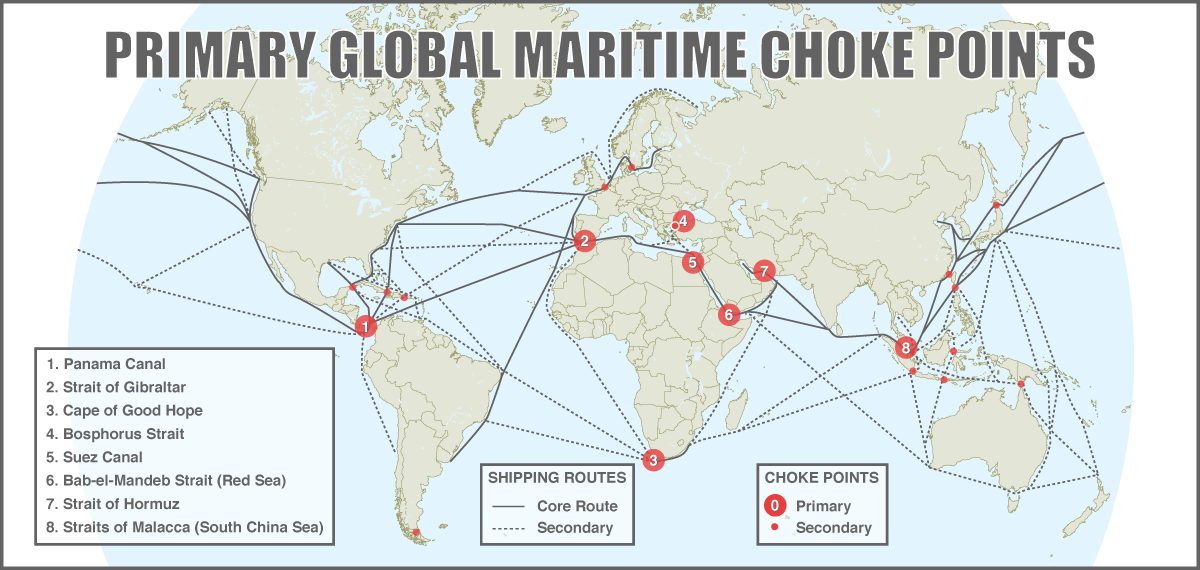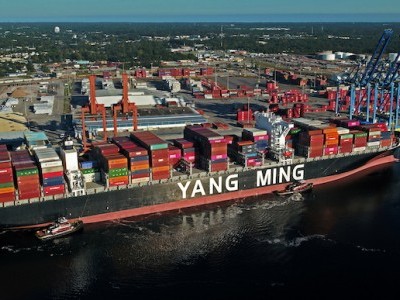Global maritime choke points
How vulnerable is global maritime commerce…maybe more than we think.

On March 23rd when the 20,000 TEU Ever Given ran aground and wedged itself across the Suez Canal, all traffic through the critical waterway came to a standstill. It was aground in the Canal for a mere six days but the cascading impact on the global supply chain is still being felt weeks later.
It’s understandable. The Suez Canal averages over 90 vessel transits a day nominally linking the Mediterranean Sea to the Red Sea. But in reality, the Suez ties Asia to Europe. The 120-mile long waterway saves around 6,100 miles of transit using London, UK – Mumbai, India as two base points. The difference is roughly 26 days to 44 in sea time.
More to the point, when it comes to moving goods to and from Asia to Europe, although it comes at a premium, the Suez Canal is really the only way to go. The alternative is going around the Cape of Good Hope, which is not only longer but would omit the port opportunities of the Mediterranean – in short, the long haul is bad business. At various times in the past, tankers have avoided using the 120 mile waterway to save cash on canal fees, but the rotations of boxships obviates this rationale. Containerships are tied to their loops and the Suez is critical to that end.
But the Suez isn’t the only maritime choke point, in fact there are eight primary maritime choke points and dozens of secondary ones (see map on next page). The primo eight (in AJOT’s estimation) are the Panama Canal, the Strait of Gibraltar, Cape of Good Hope, Bosporus Strait, Suez Canal, Bab-el-Mandeb Strait, Strait of Hormuz and Straits of Malacca.
The two canals, Panama and Suez have both become essential to the flow of containerized freight. In the case of the Panama Canal, the expansion has made it crucial as the Trans-Pacific direct call connector to the U.S Gulf and East Coast ports.
In combination with the Suez, this enables carriers to run interlinking global loops that link Asia to North America from both East and West. Which brings us to the point of vulnerabilities. If the Panama Canal had also been compromised at the same time as the Suez, what would the damage be to the global supply chain?
Of course, the majority of the choke points are “straits” which are less vulnerable to calamities like malfunctioning locks or vessel groundings but the risk factor is still significant in geo-political terms. For example, the Strait of Bab-el-Mandeb (Gate of Tears in Arabic), is located between the Arabian Peninsula and northeast Africa. The narrows are considered to be the world’s fourth busiest waterway and part of the sea route from the Indian Ocean to the Red Sea and the Suez Canal. Both sides of the waterway are volatile with the war in Yemen a global concern, unrest in Djibouti and ongoing strife in nearby Ethiopia. While a complete closure of the Strait may be unlikely, the risk level to vessel traffic in the region is still high. And an episode in the Strait – an act of piracy or armed attack on a commercial vessel – coupled with the Suez event would have been a calamity that could ignite into catastrophe.
The Straits of Malacca are another of the East-West maritime choke points. While piracy has been the main issue in the Straits, the density of traffic poses a danger in terms of collisions and other nautical misadventure. It’s estimated that 100,000 ships per year pass through the waterway that connects the Indian Ocean (via Andaman Sea) to the South China Sea.
And the South China Sea is its own kind of choke point with various interests vying for influence. China, Vietnam and the Philippines along with virtually all the other littoral states have disputes in the South China Sea. And the U.S. has a strong interest in maintaining freedom of passage through the region.
China’s buildup of island installations and militia like activities in the South China Sea are an ongoing concern to neighbors like the Philippines, Japan and the U.S. And importantly, the South China Sea is a “waterway” for trade moving between China, Southeast Asia and Europe as well as intra-Asian trade, which continues to boom and contribute to growth of ports like Singapore.
Dr. Mark Valencia, who has studied the region for decades offered the analysis should hostilities break out: “Those west of the Dangerous Ground would be the most likely to be “choked”. The alternative route to the east of the Dangerous Ground along the coasts of the Philippine islands would probably still be usable. Vessels of non-combatants could use those or go around – that is through the Indonesian archipelago or even south of Australia – although that would add considerable time and expense to the journey and thus to the cost of the goods.”
The trouble is that there are many more maritime choke points that could create a cut off of the flow of goods through the supply chain – perhaps not as thoroughly as the Ever Given – but with global impacts. And should more than one event occur simultaneously…the result could easily exceed the experience of the Ever Given event.
Similar Stories

MSC schedule update – Trade Asia to USA West Coast
View Article
Stena RoRo takes delivery of the battery hybrid vessel Guillaume de Normandie
View Article
Indian Register of Shipping reflects on 2024 and sets ambitious goals for 2025
View Article
Yang Ming announces 2025 Trans-Atlantic services
View Article
Exclusive interview with AWO’s Jennifer Carpenter
View ArticleMSC GRI - scope: USA to Bahamas
MSC Mediterranean Shipping Company Co. (USA) Inc has filled and will implement a GRI with below quantum, scope, and effective date for all DRY and Reefer containers as follows:
View ArticleGet the most up-to-date trending news!
SubscribeIndustry updates and weekly newsletter direct to your inbox!





